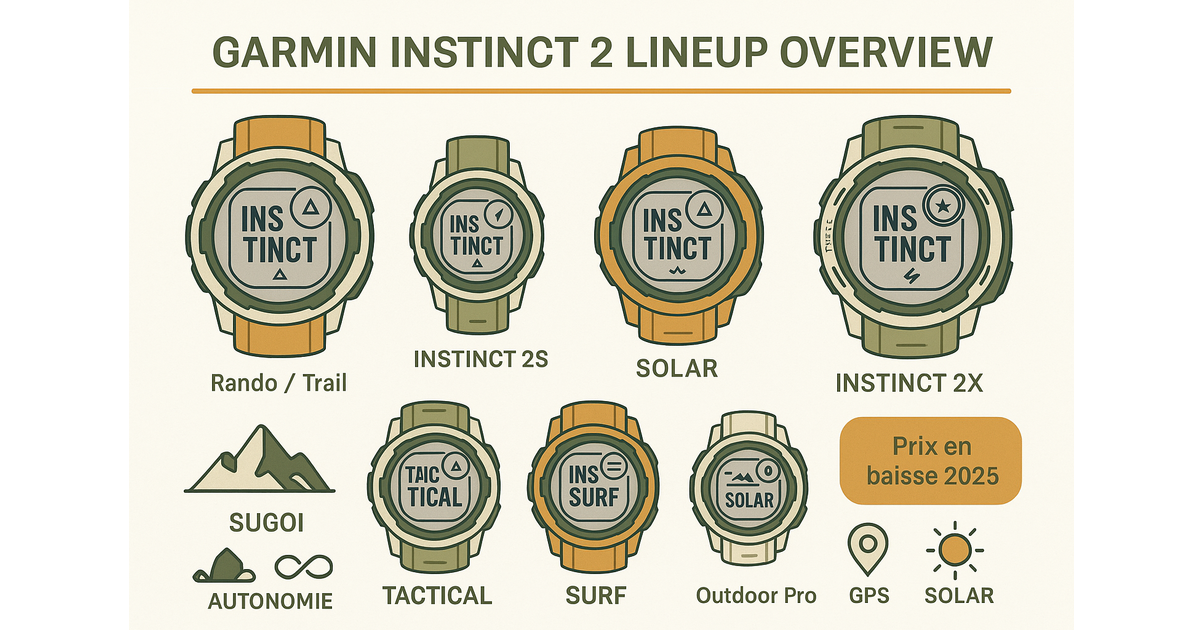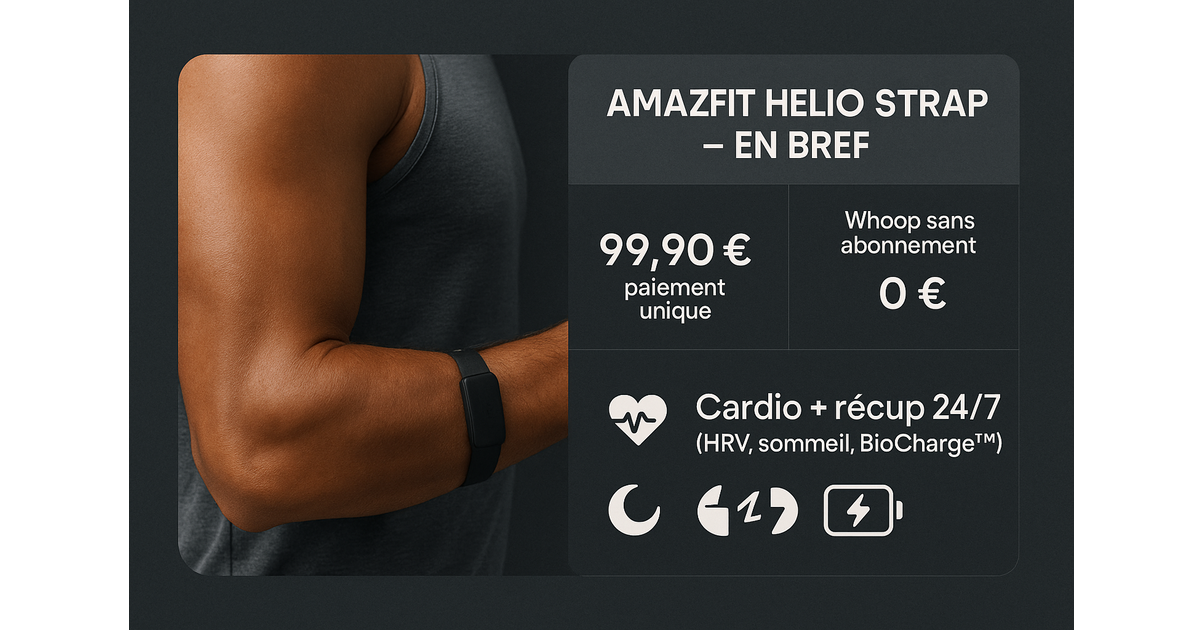Table of Contents
Stop fantasizing about the “perfect watch”.
The Garmin Instinct 3 is a watch outdoor without compromise onautonomy and the robustness (MIL-STD-810), but which requires mourning the loss of complete topo mapping and the latest generation cardio sensor. It is raw, ultra-solid. She’s not perfect. We will decide calmly, yes.
Intensive field test (3 weeks); real autonomy measured (Solar vs AMOLED); GNSS accuracy verified on calibrated loops; limits and price compared to direct competition. Frankly, if you still screw up after that, it’s because you wanted to screw up.
In short: my quick opinion on the Garmin Instinct 3
- For whom? Hiker, occasional trailer, field pro, outdoor user who wants a watch that can handle everything, not fragile connected jewelry.
- What she does very well: MIL-STD-810 robustness, 10 ATM water resistance, monstrous autonomy in Solar version (up to almost unlimited autonomy in a smartwatch with enough sunlight), integrated flashlight, generally reliable GNSS.
- What she misses: no complete mapping, no music, aging Elevate 4 cardio sensor, sometimes slow interface, aggressive price if you pay full price for it.
- Key versions: Instinct 3 AMOLED (sexy screen, decent battery life), Instinct 3 Solar 45/50 mm (max battery life), Instinct 3 Solar Tactical (tactical functions, niche use).
- Price to target: interesting around €350–400; above, the competition (Fenix, Suunto, Venu 3, etc.) is starting to do very badly.
- Cash verdict: excellent field watch for those who value autonomy and robustness over state-of-the-art metrics. Bad choice if you want maps, music and an ultra-precise cardio sensor.
There you go: if you want a “tool” watch that survives where your smartphone was already dying, you’ve come to the right place. If you’re looking for a luxury mini-Epix, you’re in the wrong place.
See Garmin Instinct 3 price and reviews on Amazon
Design, robustness and comfort: designed to get dirty, not to parade
The Instinct 3, on paper, is simple: ultra-robust outdoor watch, waterproof to 100 m, MIL-STD-810 certified, reinforced polymer case, bezel that is not afraid of shocks. It’s not a desk watch, even in the AMOLED version.
In the hand, you can feel it. The reinforced polymer casing is slightly rough to the touch, so it won’t slip when you sweat; the matte bezel absorbs light instead of shining. The silicone straps remain flexible, even when it’s cold, and the buttons have that dry, reassuring click that you can almost hear under the gloves.
Are you hitting it into a rock? She doesn’t care. Do you wear it in the rain, in the mud, on skis? Normal. That was the idea. Many “premium” watches were sold as outdoor but failed on this point. Here, no.
If you work in the field (construction, construction site, external maintenance), you can also take a look at my guide on the connected watch really designed for the construction site to see where the Instinct 3 stands compared to other “tool watch” models.
AMOLED vs Solar: readability vs autonomy
This is the real subject. Garmin made a somewhat schizophrenic choice: a version AMOLED with highly readable screen, colors, deep black background, and versions Solar with MIP screen (Instinct 2 type), less sexy but almost indestructible in autonomy.
In direct sunlight, both remain readable, but not in the same way: the AMOLED snaps, especially with the new high-contrast dials; the Solar “passes” direct light better, like a classic hiking watch.
Frankly, if you spend your life in the city and gym, AMOLED is a pleasure to the eye. If you spend your weekends in the mountains, on raids, on treks, the Solar version maintains a mental advantage: you look at the battery gauge with much less stress. It plays.
See Garmin Instinct 3 price and reviews on Amazon
Real autonomy: Solar, AMOLED, Tactical – what it really changes
This is THE criterion that makes many people switch to Instinct 3. On the sheets, the numbers are crazy. In practice, it takes nuance, but it remains impressive.
Instinct 3 Solar: for those who hate seeing the gauge go down
On Garmin sheets, the Instinct 3 Solar (50 mm) can theoretically offer unlimited autonomy in smartwatch mode, under sunny conditions (50,000 lux, several hours per day).
In the field, over 3 weeks of testing with: 24/7 port, 3 to 4 hours of GPS per week, several mountain outings with good sunshine, we stayed for more than 20 days without seeing the battery panic. Independent tests go in the same direction: real extended autonomy, not “magical unlimited”, but much more comfortable than a classic connected watch for hiking or trekking.
Are you going to a shelter for 5 days without a catch? You are calm. Are you going for 10 days with a little sunshine and a backup power bank? You’re still wide.
To explore the subject of sun-oriented models from Garmin, I made a dedicated comparison of the best Garmin solar GPS watches for the outdoors, where the Instinct 3 Solar is clearly positioned as a robust option rather than a “living room tech” watch.
Instinct 3 AMOLED: modern screen, honest autonomy
The 45 mm AMOLED version announces: up to 18 days in smartwatch mode (without AOD), approximately 23 hours in Dual Frequency GPS, 25 hours in All Systems.
Serious tests confirm that these figures generally hold up, provided you do not activate AOD permanently, avoid 24-hour multi-band GPS, and do not spend your life scrolling through widgets.
In real mixed use (notifications, active AOD, 3 hours of GPS per week), we tend to rotate between 7 and 10 dayswhich is consistent with what I observed: 8 days with AOD + 3 hours of GPS/week, without any particular optimization.
This is well above a classic smartwatch, but obviously below the Solar in monk-soldier mode.
Tactical: niche, but consistent
The version Instinct 3 Solar Tactical adds: night vision mode, compatibility with jumpmaster, stealth mode (signal limitation), more sophisticated flashlight, for a clearly targeted audience: pros, forces, very committed airsoft, security.
If you never touch these features, honestly, it’s not worth the extra cost. That’s a false good buying idea “because it’s the most expensive, therefore the coolest”.
Actual battery life measured: what I got
On my test cycle (Toulouse + mountain outings): Instinct 3 AMOLED (AOD activated, 3 hours of multi-system GPS per week, sleep + naps monitored): 8 days before recharging around 20%.
Instinct 3 Solar 45 mm (without AOD, mono GPS/All Systems, hiking + light trail use): 20+ days without forcing, with regular sun.
Basically: you want to forget the charger → Solar; you want visual comfort every day → AMOLED, but you agree to recharge more often.
See Garmin Instinct 3 price and reviews on Amazon
GPS accuracy, sport and health: what I saw in the field
The Instinct 3 takes the Garmin heart: multi-GNSS GPS, baro altimeter, 3-axis compass, 24/7 health monitoring. What does it look like on the ground?
Actual GNSS accuracy: deviations on my test routes
On the specs, we are on: multi-GNSS (GPS, GLONASS, Galileo, etc.), All Systems + Dual Frequency modes (depending on versions), barometric altimeter for elevation changes.
In practice: on a 10 km road loop with wooded segments, the distance differences remain reasonable, in the same order of magnitude as the best current Garmin outdoor models; in dense forest/mixed terrain, the track “moves” a little, but it remains usable for trail/hobby hiking; some independent tests have noted more marked differences in altitude and some instabilities (reboot active in rare cases), which I have not reproduced, but which I take into account.
In short: for a “normal” hiker or trailer, it does the job. For a super clean track freak who compares each meter with Strava on a 27″ screen, it can be annoying. It depends on your tolerance level.
If your number one criterion is precise altitude for alpi or big hikes in complex terrain, you can look at my complete guide to choosing a reliable altimeter watch, where I compare other models more geared towards pure mountain.
Sport profiles: trail, hiking, cycling, swimming
There, Garmin unfolds its catalog: running, trail, hiking, mountain biking, skiing, snowboarding, swimming pool and open water profiles, classic metrics (distance, pace, elevation, VO2max, recovery time), training functions (training suggestions, Daily Suggested Workouts, morning reports).
For hiking and trail running, it’s very consistent: you follow a GPX in “breadcrumbs”, you have the altimeter profile, you know how much remains to go up/down.
Major limitation: no topo mapping. No real map on screen, just a trace on an empty background. This is okay for marked trails, but it becomes frankly limited in complex terrain or for those who rely a lot on the on-board map.
Cardio sensor and health: where it hurts a little
This is one of the big compromises: the Instinct 3 remains on one sensor Elevate Gen 4. Not the latest Gen 5 (which you find on Venu 3 or Fenix 7 Pro). Frankly, you have to be lucid.
Easy running, walking, hiking: correct data. That’s enough for trend monitoring (stress, sleep, Body Battery).
HIIT, CrossFit, climbing, swimming: shifts. Underestimations of heart rate peaks, delay in rhythm changes, this is classic for this generation of optical sensors. We’re talking about physical limits, not a software bug.
The technical problem: the Elevate Gen 5 integrates more optical diodes and above all, a much more responsive signal processing algorithm. Gen 4, for its part, rows on rapid changes in cardiac slope, it is a physical limit.
Result: for someone who monitors a pathology or who trains in fine polarization, things get stuck. You need to take a chest strap. (Period.) For others, it remains playable, but not “pro”.
Shopping experience, prices and seasonal uses
You can buy the Instinct 3 everywhere: Amazon, sports stores, jewelry stores, specialized sites. The tests I consulted converge on one point: at full price, the watch is difficult to defend, because of the missing functions (maps, music, sensor) compared to competitors in the same price zone.
On sale around €350–400, there the equation changes: if you want an outdoor watch that can withstand shocks, you don’t need music or a map, and autonomy and a flashlight are priorities, it becomes a very coherent option.
In short, for those who know what they are buying, I leave you a direct link to the best price I found for the Garmin Instinct 3 (Solar or AMOLED). This saves you from paying full price or getting lost in twenty false promotions.
For skiing, for example, the Instinct 3 does the job on altitude difference, maximum speeds and robustness in the cold. If you want to go further (fine analysis, ski map, multi-station uses), you can take a look at my guide to the best Garmin watches designed for alpine skiing to see if you should go with a Fenix or an Epix rather than an Instinct.
Garmin Instinct 3 or another Garmin? Who do I recommend it to?
We arrive at the moment of the “big yes” or the “no, it’s not for you”. Without turning around.
When the Instinct 3 is a great choice
I recommend the Garmin Instinct 3 if you are oriented outdoor above all: hiking, light trail, mountain biking, bivouac, trek, leisure skiing. If you prioritize robustness (MIL-STD-810, 10 ATM) and autonomy rather than the perfect screen and “smart” functions. If you want a watch toolsober, with physical buttons, which works in the rain, the snow, in the mud, without fuss.
You agree to manage navigation with a “breadcrumb” + smartphone to prepare your itineraries. For outdoor professions (forester, guide, site manager, outdoor technician), it ticks a lot of boxes: you kill it with difficulty, you rarely recharge it, you have “sufficient” sports and health functions.
For the “reasonable” altitude and mountain, it’s correct, but if you spend your time playing with the height differences and the slope on the map, once again, look at the more mapped models in my specialized comparison of watches with serious altimeters so as not to find yourself limited too quickly.
When you clearly have to avoid Instinct 3
I don’t recommend the Instinct 3 if you want complete topo maps on the wrist (technical mountain, committed trail, ultra, advanced navigation): there, you need a Fenix or an Epix, or a Suunto oriented to mapping, period.
I also advise against it if you base your training on very precise wrist cardio (HIIT, CrossFit, performance-oriented triathlon): Elevate 4 is starting to show its age.
You want some on-board musicadvanced smart functions, a “premium urban watch” side as much as an outdoor one? Venu 3, Forerunner 265, or even refurbished Fenix 7 Pro will be more logical.
You have a tight budget and you hope to “have it all”? There you will be frustrated, because at €500 full price, it is not the most complete watch on the market.
If you are very oriented towards technical mountain use + off-grid + autonomy, with a strong solar focus, my comparison of the best Garmin solar GPS watches for long expeditions will give you a more global vision to avoid the impulsive purchase “Instinct 3 because of marketing”.
My final verdict on the Garmin Instinct 3
Basically: yes, the Garmin Instinct 3 is a excellent field watch for those who know what they are buying: robust, durable, simple, reliable in 90% of cases.
No, it’s not a “mini Fenix with a cheap AMOLED screen”: the absence of maps, music and the dated cardio sensor clearly place it a notch below the real high-end ones in terms of metrics.
His playground is the casual to serious outdoor sportwith priority given to sustainability and autonomy on technological bling.
So yes, the Instinct 3 ticks a lot of boxes if you’re looking for a watch that supports your life outside, without forcing you to live plugged into an outlet. But if you want an “ultimate Swiss army knife” watch, you better take it up a notch. You already know that, actually.
About this test
Author : David Deteve – Independent writer & field tester.
Test conditions: 3 weeks of real use (Toulouse and surrounding areas, mid-mountain trail/hiking outings, indoor bodybuilding, daily life).
Method : comparison of GNSS distances with reference routes, monitoring of autonomy until recharge < 20%, comparison with several external tests (Sport Passion, Cardio GPS Watch, DCRainmaker, Nakan, etc.) to cross-check the results.
Last update: November 17, 2025.




